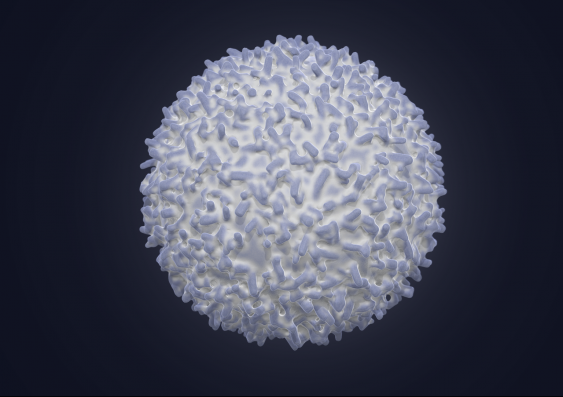Unravelling sex differences in autoimmune diseases
2024-09-05T07:17:00+10:00

Adobe Stock Images
There's still much to learn about the link between sex differences and autoimmune diseases, which affect more females than males and currently have no cure.
Autoimmune diseases ≤π∞˘±Ã˝a leading cause of death¬Ýin women under 65, and they're¬Ý¬Ýto develop in females than males.
For the 80 or autoimmune diseases, there are no known cures.
Autoimmunity is complicated by anomalies. While most of these diseases are more common in women, such as rheumatoid arthritis, multiple sclerosis, lupus, Crohn's disease and Graves' disease, young Australian males are 30 percent more likely to be diagnosed with type 1 diabetes than females.
This highlights the need to comprehensively study the sex differences across each disease to achieve better patient care — which is a new way of thinking that is beginning to transform medicine.
It's hoped that, by identifying how sex — along with genetic make-up, risk exposure and age — influence autoimmunity, researchers can crack the codes on how to manage and possibly even cure each of these diseases.
What causes autoimmune diseases in females?
First, a quick primer on how autoimmune diseases come about. Essentially, they result when the immune system derails.
A healthy immune system is an incredible surveillance operation that circulates squads of specialised white blood cells to seek-out and neutralise foreign risks and remove damage. If that finely tuned system gets misdirected, it can trigger self-eradication activities that develop as autoimmunity.
These include disease in a specific organ (for example, the pancreas in type 1 diabetes), a body system (for example, myelin across the brain and spinal cord in multiple sclerosis), or the whole body (for example, joints in rheumatoid arthritis; or joints, tendons, kidneys and skin in systemic lupus).
Females tend to have stronger immunity, which makes them more prone than males to immune overreaction.
The lottery of genetic inheritance predisposes some families. Environmental triggers including infections, disturbed microbiomes, or even chemical exposures, ≤π∞˘±Ã˝¬Ýof sending things off course.
The hormone connection
Immunity in females is especially tied to sex hormones and most autoimmune diseases onset¬Ý.
While hormones don't trigger autoimmune onset themselves, they appear influential. For example: oestrogen is a major regulatory hormone in females that generally activates immune responses.
Its levels naturally fluctuate across the life course: rising at puberty; oscillating over the menstrual cycle; becoming irregular at perimenopause and declining at menopause. Oestrogen levels can also be artificially adjusted in response to oral contraceptives or hormone-replacement therapy.
Oestrogen is considered a risk factor for lupus because symptoms can flare up in response to oestrogen-based oral contraceptives, and in response to menopausal hormone replacement therapy. Some studies¬Ý¬Ýperiodic flare-ups of lupus across the menstrual cycle with oestrogen, whose levels typically peak a couple of days prior to ovulation.
In contrast to lupus, oestrogen is a benefit in multiple sclerosis. Oestrogen protects the brain,¬Ý.
Oestrogen also appears beneficial in type 1 diabetes, but for different reasons.
Type 1 diabetes is an unusual autoimmune disease because its prevalence is higher in males than females under 70 years,¬Ý. In female patients, though, the condition is particularly deadly: it is¬Ýincreased risks of stroke and heart attack.
Oestrogen's role in type 1 diabetes¬Ý. In premenopausal females, the capacity of oestrogen to stimulate insulin production and in turn down-regulate blood glucose levels¬Ý¬Ý‚Äî at least early on, until autoimmune destruction of the insulin-producing cells of the pancreas advances.
During menopause, a decline in circulating levels of oestrogen may profoundly influence autoimmunity. Women develop the first signs of rheumatoid arthritis, on average, around menopause.
Multiple sclerosis patients¬Ýat this stage. And although disease flares may become less frequent in lupus patients, the accumulated damage continues compounding beyond menopause.
Pregnancy: a mixed picture
Hormones are also crucial to pregnancy.
Pregnancy often corresponds to reduced autoimmune symptoms ‚Äî which is¬Ý¬Ýhormonal suppression of the mother's immune system to prevent miscarriage.
But this link is¬Ý. For example, pregnancy can mitigate symptoms of pre-existing lupus for some, heighten symptoms for others, or even accompany onset. Unfortunately, complications due to lupus damage may be dire for both the mother and the fetus.
Rheumatoid arthritis may also have this varied expression during pregnancy, which can complicate delivery and infant care if affecting maternal hips or spine, but it does not affect the fetus directly.
Similarly inconsistent outcomes occur among patients with Crohn's disease who conceive while their disease is active: with around one-third going into remission, another third remaining stable, and the remainder worsening.
Let's talk about X chromosomes
X chromosomes are also linked to autoimmunity — and emerging research in this space is exciting, because it offers the possibility of targeting therapy with more precision.
Females have a particularly high risk of autoimmune diseases related to their two Xs, in contrast to a single copy in males. Importantly, only one X is fully expressed at any one time in a female cell, the second X is shut down almost entirely — but some genes escape silencing, and among them are immune genes.
One example is an immune gene that is important in responding to viral infection. If it occurs at high levels, it is¬Ý¬Ýfor lupus. This is a danger for some females, and also Kleinfelter males with multiple Xs.
Unexpectedly, a¬Ý¬Ýfound that the molecular complex involved in shutting down one of the female Xs can also become an autoimmune target in lupus.
Research priorities offer hope
With no known cure for autoimmune diseases, three key priorities for researchers include unravelling these conditions' causes, exposing their drivers, and uncovering symptom management.
Understanding genetic risks that predispose to immune overreactions is a burgeoning area. The new era of gene editing using technology known as ‘clustered regularly interspaced short palindromic repeats' (CRISPR technology) offers exciting scope.
The success of this work, however, will rely on precise identification of gene mutations causing disease, in order to specifically correct the coding errors. For example, correcting an immune gene on the X chromosome¬Ýfor treating lupus.
Controlling hormone levels is one approach to disease regulation that's increasingly being studied.
For example,¬Ý¬Ýof hormones such as androgens and progesterone is relevant to rheumatic diseases. So, too,¬Ýoestrogen supplements in females and testosterone modulators in males with multiple sclerosis.
But controlling hormone levels to regulate autoimmune conditions is not simple: each disease is different, and tailoring to individual patients is likely to be helpful.
Cautionary tales are emerging regarding the relevance of¬Ý¬Ýin models for this work. As an example,¬Ý¬Ýthat showed promise in animal models of multiple sclerosis, require more expansive clinical trials to properly assess their impact on diverse human populations.
To help us better understand how to manage autoimmune diseases, it will be crucial to identify how risk exposure, age, sex and genetic make-up influence autoimmunity.
There is a startling gap in this area of research. As of 2022, no insulin pump manufacturers¬Ý¬Ýa sex-specific insulin infusion profile, despite obvious hormonal influences on the disease.
With increasing prevalence of autoimmune diseases in the industrial world ‚Äî at around¬Ý¬Ýaffected ‚Äî there is a clear need to properly fund and widely study these conditions.
As no two autoimmune diseases are the same, with symptoms varying between each patient, personalised treatment is a promising path to improving the patient experience and ultimately relieving a mounting burden.
The information in this article is provided for educational purposes and is not to be taken as medical advice.
Dr Sue Haupt¬Ýis a Senior Research Fellow at the Centre for Sex and Gender Equity in Health and Medicine at the George Institute for Global Health at ’¨ƒ–∏£¿˚ and an Honorary Senior Research Fellow at the Sir Peter MacCallum Department of Oncology, University of Melbourne.
Prof Bronwyn Graham¬Ýis the Director of the Centre for Sex and Gender Equity in Health and Medicine at the George Institute for Global Health and a Professor in the School of Psychology, ’¨ƒ–∏£¿˚ .
Prof Rachel Huxley¬Ýis the Deakin distinguished Professor and Executive Dean, at the Faculty of Health, Deakin University; and Co-Director of the Centre for Sex and Gender Equity in Health and Medicine at the George Institute for Global Health, ’¨ƒ–∏£¿˚ .
Originally published under¬ÝÃ˝≤˙≤‚Ã˝‚Ñ¢.





